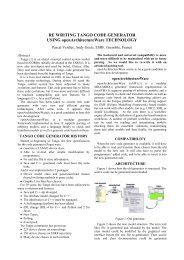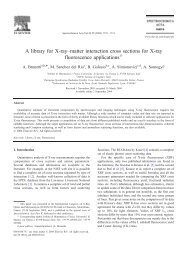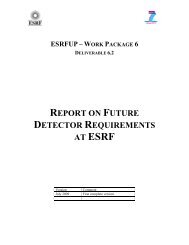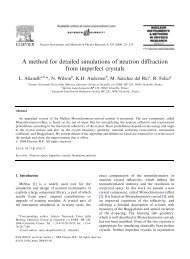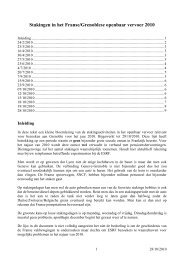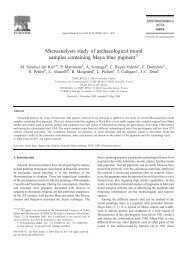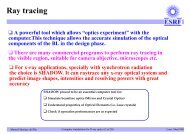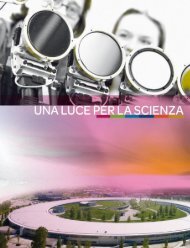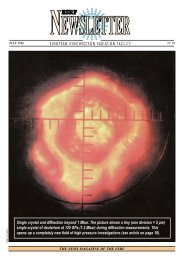New Scientific Opportunities at the European Synchrotron Radiation ...
New Scientific Opportunities at the European Synchrotron Radiation ...
New Scientific Opportunities at the European Synchrotron Radiation ...
You also want an ePaper? Increase the reach of your titles
YUMPU automatically turns print PDFs into web optimized ePapers that Google loves.
<strong>European</strong> <strong>Synchrotron</strong> Radi<strong>at</strong>ion Facility Long-Term Str<strong>at</strong>egy 7 July 2006<br />
world-leading investig<strong>at</strong>ions exploit <strong>the</strong> time structure (down to ~100 picoseconds) of<br />
special storage ring oper<strong>at</strong>ion modes. These studies will explode in importance when<br />
<strong>the</strong> new XFELs become available, as demonstr<strong>at</strong>ed by <strong>the</strong> ground breaking work <strong>at</strong><br />
<strong>the</strong> TTF2 facility <strong>at</strong> DESY, in <strong>the</strong> VUV, and in <strong>the</strong> X-ray region <strong>at</strong> <strong>the</strong> SPPS <strong>at</strong> SLAC.<br />
Instrument optimis<strong>at</strong>ion and new beamlines <strong>at</strong> <strong>the</strong> ESRF will permit both diffraction<br />
and spectroscopic investig<strong>at</strong>ions, setting <strong>the</strong> scene for sub-picosecond XFEL science<br />
in <strong>the</strong> decades after 2010.<br />
Picosecond time-resolved diffraction has proved to be a very powerful tool to track<br />
<strong>the</strong> structure of molecules as <strong>the</strong>y change shape and composition during a chemical<br />
reaction. These experiments are performed in a pump and probe fashion:<br />
femtosecond laser pulses excite a sub-set of molecules in <strong>the</strong> sample, and delayed<br />
X-ray pulses probe <strong>the</strong> structure <strong>at</strong> a given delay. The diffraction p<strong>at</strong>terns are<br />
recorded on a CCD detector and by varying <strong>the</strong> time delay, from 100 picoseconds to<br />
milliseconds, a real-space film can be made by Fourier inverting <strong>the</strong> diffraction<br />
p<strong>at</strong>terns. Laue diffraction studies are usually conducted in <strong>the</strong> 4-bunch mode of<br />
storage ring oper<strong>at</strong>ion, which gives <strong>the</strong> highest number of photons in a single shot.<br />
The best example is <strong>the</strong> recording of <strong>the</strong> dissoci<strong>at</strong>ion of CO from <strong>the</strong> myoglobin<br />
complex MbCO. One of <strong>the</strong> key questions to address in <strong>the</strong> next few years is <strong>the</strong> role<br />
of w<strong>at</strong>er molecules in protein dynamics. Indeed, new experiments have been able to<br />
resolve w<strong>at</strong>er motions in certain proteins.<br />
Solution Phase X-ray Diffraction (SPXD) is ano<strong>the</strong>r field where <strong>the</strong> ESRF has made<br />
important contributions. These experiments use a moving sample, which makes it<br />
possible to study irreversible reactions <strong>at</strong> high frequency, ~1000 Hz. Using <strong>the</strong><br />
intense pink beam from a single harmonic of a short period in-vacuum undul<strong>at</strong>or it is<br />
now possible to acquire diffraction spectra, with 100 ps time resolution, <strong>at</strong> a r<strong>at</strong>e of 20<br />
per hour. The spectra measure <strong>the</strong> laser-induced change in <strong>at</strong>om-<strong>at</strong>om correl<strong>at</strong>ions<br />
during a chemical reaction. The experiments have shown <strong>the</strong> sign<strong>at</strong>ures of <strong>the</strong><br />
form<strong>at</strong>ion and breakage of bonds, gemin<strong>at</strong>ed and non-gemin<strong>at</strong>ed recombin<strong>at</strong>ion of<br />
products, <strong>the</strong> solvent structure around <strong>the</strong> products and <strong>the</strong> hydrodynamics of <strong>the</strong><br />
solvent medium (i.e. <strong>the</strong> change in temper<strong>at</strong>ure, pressure and density). These<br />
experiments are analysed using molecular dynamics simul<strong>at</strong>ions (MD), classical<br />
hydrodynamics and st<strong>at</strong>istical <strong>the</strong>ory of liquids.<br />
Interest is turning towards larger and more complex molecules. The recent results<br />
obtained for <strong>the</strong> allosteric transition of haemoglobin show th<strong>at</strong> studies can be<br />
extended to macromolecular assemblies. There are strong indic<strong>at</strong>ions th<strong>at</strong> protein<br />
dynamics (folding/unfolding) can be studied in <strong>the</strong> n<strong>at</strong>ural environment in this way.<br />
Nano-scale crystals should also be mentioned, where plasmons can be excited by<br />
laser pulses. The electron energy is transported, via <strong>the</strong> electron-phonon interaction<br />
to <strong>the</strong> l<strong>at</strong>tice, and coherent vibr<strong>at</strong>ions have been observed in powder diffraction. Very<br />
small nano-particles with diameters down to 5 nm are also likely to be paarticularly<br />
interesting as an intermedi<strong>at</strong>e between a molecule and a crystal (giving rise to Debye<br />
sc<strong>at</strong>tering r<strong>at</strong>her than crystal diffraction). The physics of such many-body molecules<br />
will undoubtedly become a fascin<strong>at</strong>ing area of research.<br />
An increased effort must be made to fur<strong>the</strong>r develop time-resolved sub-nanosecond<br />
X-ray sc<strong>at</strong>tering and spectroscopy through beamline development and by exploiting<br />
new storage ring oper<strong>at</strong>ing modes to provide new possibilities for <strong>the</strong>se techniques.<br />
10



